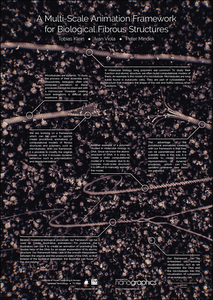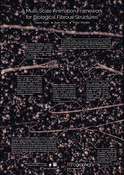Information
- Publication Type: Poster
- Workgroup(s)/Project(s):
- Date: 2019
- Event: EuroVis 2019
- DOI: https://doi.org/10.2312/eurp.20191149
Abstract
Fibrous structures are ubiquitous in cell biology and play essential structural and functional roles in the life cycle of a cell. They are long polymers, such as DNA carrying genetic information, or filaments forming the cytoskeleton, crucial for cell division and maintaining the cell shape. In order to disseminate new findings of such structures to peers or a general audience, animated 3D models of these structures have to be created, as they are too small to be imaged with microscopes. However, this is a tedious task carried out by scientific animators, who manually create expressive visual representations of biological phenomena. In this work, we present a novel concept which simplifies the process of animating multi-scale procedural models of biological fibrous structures. In contrast with existing work in the domain of molecular visualization, our approach can also capture dynamics, which are important to show when communicating biological processes.Additional Files and Images
Weblinks
BibTeX
@misc{klein_2019_MSA_Poster,
title = "A Multi-Scale Animation Framework for Biological Fibrous
Structures",
author = "Tobias Klein and Ivan Viola and Peter Mindek",
year = "2019",
abstract = "Fibrous structures are ubiquitous in cell biology and play
essential structural and functional roles in the life cycle
of a cell. They are long polymers, such as DNA carrying
genetic information, or filaments forming the cytoskeleton,
crucial for cell division and maintaining the cell shape. In
order to disseminate new findings of such structures to
peers or a general audience, animated 3D models of these
structures have to be created, as they are too small to be
imaged with microscopes. However, this is a tedious task
carried out by scientific animators, who manually create
expressive visual representations of biological phenomena.
In this work, we present a novel concept which simplifies
the process of animating multi-scale procedural models of
biological fibrous structures. In contrast with existing
work in the domain of molecular visualization, our approach
can also capture dynamics, which are important to show when
communicating biological processes.",
event = "EuroVis 2019",
doi = "https://doi.org/10.2312/eurp.20191149",
Conference date = "Poster presented at EuroVis 2019 ()",
URL = "https://www.cg.tuwien.ac.at/research/publications/2019/klein_2019_MSA_Poster/",
}



